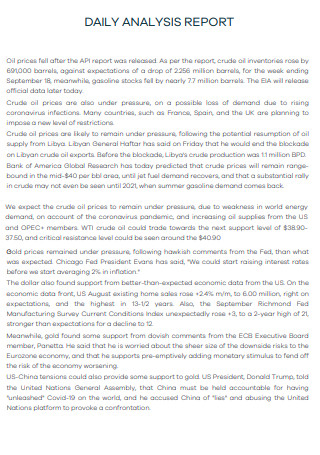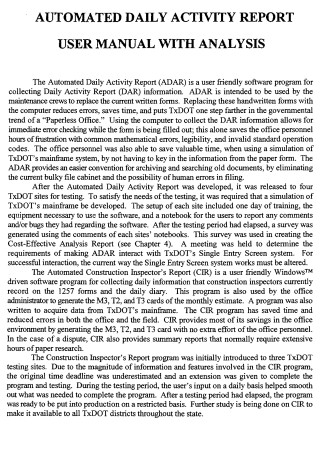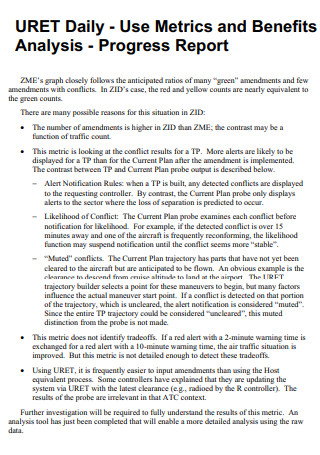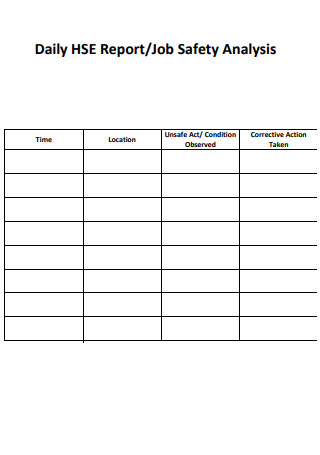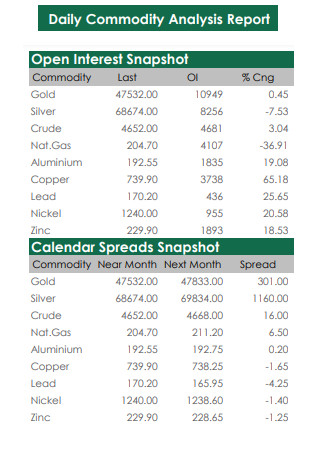5+ SAMPLE Daily Analysis Report
FREE Daily Analysis Report s to Download
5+ SAMPLE Daily Analysis Report
a Daily Analysis Report?
Benefits of Analysis Report
Tips For Creating Effective Business Reports
Types of Daily Reports
How To Write a Daily Analysis Report
FAQs
What is the format of an analysis report?
What is the primary reason for conducting data analysis?
Why is data analysis necessary?
What Is a Daily Analysis Report?
A daily analysis report is a production report that groups hotel nights and revenue earned by the stay date group. The grouping is usually done within a week. However, any date can be used. According to a recent study, 51% of businesses have built a direct link between their business impact and their human resource strategies. As a result, 44% of companies employ predictive analytics to collect and evaluate personnel data.
Benefits of Analysis Report
When businesses develop a marketing, sales, or operational strategy, they often use existing data or information. Because new customers and transactions make data grow and change, business owners can use this information to change their strategy and improve their bottom line and operational efficiency. The following are some of the benefits of analysis reports if you’re still interested in them.
Tips For Creating Effective Business Reports
A well-written business report is critical to the success of any endeavor. You may work diligently and achieve great things. However, if you want your labor to be fully appreciated, your report should be remarkable. It is insufficient to present the research’s essential concepts and data. Naturally, relevant and reliable data are critical. Thus, there are several crucial recommendations that one should be aware of when composing a fantastic business report. Consider them, as well as our templates. We are confident that you will discover the ideal method for completing your report.
Types of Daily Reports
Reporting is an integral part of the business. Having knowledge of the different types of reports and when you need to use them for your business or organization is very important. It’s not enough to know how to write a report. The right kind of reports can impact an organization, changing how people do their jobs and make decisions. This part will discuss some types of reports that you can use and help you figure out how you can use them.
1. Annual Report
Each year, businesses put out an “annual report” that talks about how well the company did and how much money it made in the previous year. The first few pages of the report have an eye-catching design and give an overview of the organization’s past year’s work and plans for the future. Organizations use this report to tell shareholders and other people who want to know more about how their business is doing and how it makes money. An essential thing in this list is the annual report, which is sometimes required by some jurisdictions.
2. Weekly Report
A weekly report looks back at the work you did last week, including the projects you finished and the ones that are still in progress. This helps you plan your job for the next week. So, a weekly report and an annual report are both about the same. But annual reports give a general picture of a year, while weekly reports give a week’s photo. Take a look at what the employees are doing, including doing well and what they are having problems with. On the other hand, the report can give employees an idea of their job in the company.
3. Sales Report
People in sales write sales reports to tell their team about what happened on the job. A sales report is a document that sums up a company’s sales performance over a certain amount of time. It shows how many leads were generated, how many new accounts were set up, and the revenue was made. So you don’t have to guess when you make business decisions. It also gives you a clear picture of how your business sells. One of the most important things about these reports is that you can set them up to come out at different times and with various key performance indicators.
4. Analytical Report
Over the last decades, data analysis has become an essential part of business intelligence and common practice in the business world. According to data from around the world, big data analytics will make $68 billion in revenue each year by 2025. This is because most businesses change their strategies based on data-driven insights. Without data analytics in this modern world, there can’t be any business growth. In this part of the story, the analytical reports come into play. An analytical report lets you see how your business is doing based on data. To get the best outcomes, you should read these reports. They give you advice instead of letting you play with numbers.
5. Marketing Report
If you’re a marketer, you understand that no matter how great your marketing campaign was, you need to watch every part of it. It will help you figure out how to market your business, giving your bosses the information. So, making a marketing report is an integral part of every marketing plan. A marketing report includes data from your marketing channels to see how your campaign worked together. They help you determine whether the marketing strategies you’re currently using are working and know if they need to change.
6. Budget Report
A budget report compares how much money was spent and how much money was set aside. Businesses need to make accurate and informed financial decisions. When you make a budget report, you usually set financial goals for your company. After a business has a specific accounting period, it can use a budget report to see how these milestones compare. However, the budget reports are only guesses, and the financial results are not the same as the budget.
7. Event Report
It is essential to have an event report to determine if an event was a success by comparing how well it worked and how well the goals were met. If you work as an event manager, you should have an event report in your toolbox. A report on an event can come in many different forms, but its primary goal is to make it go well. Besides that, you can think of it as a follow-up to a proposal for an event. You can learn about the event’s goals, budget, and more.
How To Write a Daily Analysis Report
After learning what a daily analysis report is and what it accomplishes, it’s time to begin creating one. You can write your paper report in Google Docs or Microsoft Word, depending on your preference. However, writing requires a significant amount of time and research, and you may end up with no valuable data insights. If you want to preserve time and boost your efficiency, invest in a technology that automates the process.
1. Recognize the Issue
The first stage in developing an analytical report is determining the nature of the problem and the individuals affected. Ensure that you accurately characterize the situation by giving information about how it began, the approaches utilized to fix it thus far, and their success. An excellent example of an analytical report is one about student delays at a particular school. In this instance, we have a well-defined issue. We’ve established that it affects children, teachers, and parents. Finally, we discuss the techniques attempted to resolve the issue, one of which was an unsuccessful incentive system.
2. Justify Your Techniques
Second, you should detail the methods you utilized to determine the success of your actions in the report. Additionally, you should include one or two new approaches to test. For instance, a piece of information on a failed advertising campaign may disclose that surveys of a sample population discovered the success factor.
3. Analyze Information
Analytical reports contain a complete examination of the data gathered via the research methodologies. As you are aware, the report was written to address a specific issue and recommend possible solutions. Thus, it would be beneficial to examine the success or failure of the initial solutions you attempted. To further comprehend the analysis process, assume that you’re preparing an analytical report on speed limit compliance. You’re evaluating and comparing the success and failure of previously recommended remedies such as speed bump construction, the placement of speed limit signage, and the use of police traffic stops. Analyzing the data gained from experimenting with various strategies will assist you in determining which was the most effective for your organization. You may even discover that combining two methods resulted in tremendous success.
4. Make Suggestions
Finally, your analytical report should offer recommendations for resolution. Additionally, it would be beneficial to include these solutions at the end of your report. By developing a few suggestions, you’ll be able to make data-driven judgments rather than relying on guesswork.
FAQs
What is the format of an analysis report?
Even though the needs and audience of an analytical report may be different, they usually have the same elements: a title page, a table of contents, a methodology section, a body section, a conclusion and recommendation section, a bibliography, and an appendices section.
What is the primary reason for conducting data analysis?
Analytical and logical thinking are used to extract relevant information from data. The primary goal of data analysis is to comprehend the data and obtain meaningful information that can aid in decision-making.
Why is data analysis necessary?
In research, data analysis aims to present accurate and dependable data. Avoid statistical errors as feasible and devise a strategy for dealing with common obstacles such as outliers, missing data, data manipulation, data mining, or producing graphical representations.
This is a type of work that requires extreme precision. Thus you must give data that originated from a reputable source. If you’re interested in seeing other samples and formats, look at some of the daily analysis report samples and templates offered in the post.

